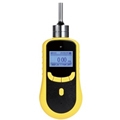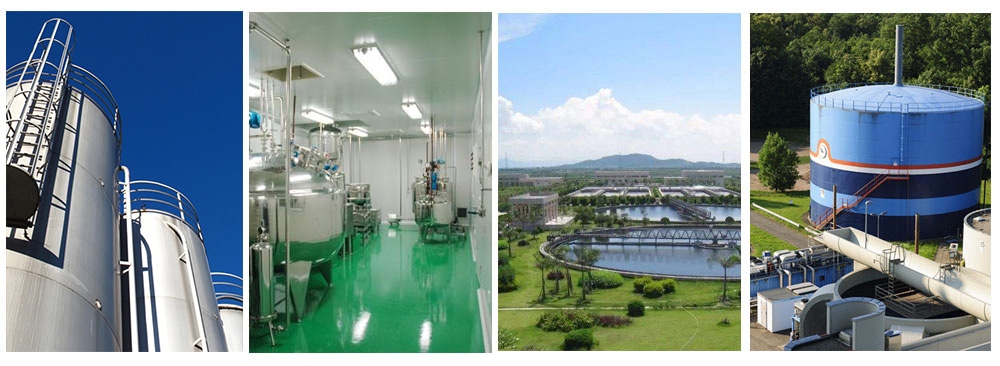Chlorine is a yellow-green toxic gas with a pungent odor at normal temperature and pressure and has strong oxidizing properties. It is widely used in disinfection, bleaching, and chemical industries, such as in the production of chloride, bleach, and PVC. Due to its toxicity and irritation, Cl2 gas leaks or exposure to high concentrations of Chlorine are harmful to human health and require careful handling and storage. A Chlorine gas detector is a gas monitor used to detect the concentration of Chlorine (Cl2) to ensure the safety of the working environment and prevent Cl2 poisoning incidents.
Cl2 Gas Detector Working Principle
Cl2 gas detectors usually use electrochemical sensors to detect Chlorine concentration. Such sensors are based on redox reactions, in which Cl2 reacts with a material on the surface of an electrode to produce a measurable current or voltage signal. Here is how a typical electrochemical sensor works:
- Working electrode (sensing electrode): The working electrode is usually made of metal or metal oxide. When Chlorine contacts the surface of the working electrode, it undergoes a redox reaction with the material on the surface.
- Reference electrode: The reference electrode is used to provide a stable potential to compare with the potential of the working electrode. This helps ensure the stability and accuracy of the sensor output.
- Electrolyte: The electrolyte is a medium filled between the working electrode and the reference electrode, usually a liquid or gel. It conducts ions and helps maintain the potential difference between the electrodes.
- Working: When Cl2 contacts the surface of the working electrode, it may accept electrons and undergo reduction, or release electrons from the surface and undergo oxidation. This redox reaction results in a change in current or voltage that is proportional to the concentration of Cl2. By measuring this change, the concentration of Chlorine can be determined.
- Output signal: The sensor converts the detected current or voltage signal into a digital signal and displays it on the monitor’s screen or provides it to the user through other output interfaces.
What are the Types of Cl2 Gas Detectors?
Portable Cl2 Gas Detector
 Portable Chlorine gas detectors are usually designed as handheld devices that are easy to carry and operate. They are suitable for situations where mobile gas detection is required, such as on-site emergency response, regular inspections, or mobile operations. This type of detection instrument usually has an easy-to-read digital display that can monitor the Cl2 concentration in real-time and usually has an audible or visual alarm function to remind the user to take action when dangerous concentrations are reached.
Portable Chlorine gas detectors are usually designed as handheld devices that are easy to carry and operate. They are suitable for situations where mobile gas detection is required, such as on-site emergency response, regular inspections, or mobile operations. This type of detection instrument usually has an easy-to-read digital display that can monitor the Cl2 concentration in real-time and usually has an audible or visual alarm function to remind the user to take action when dangerous concentrations are reached.
Fixed Cl2 Gas Detector
 Fixed Chlorine gas detectors are installed in a specific location and are usually integrated with a gas alarm system. These detection instruments are suitable for environments where long-term monitoring of Chlorine concentration is required, such as factories, laboratories, or other places where Chlorine gas may leak. They usually have higher sensitivity and more stable performance, and can continuously monitor gas concentrations and trigger alarms or automatically take measures when a predetermined threshold is reached, such as starting a ventilation system or shutting down a feed pipeline.
Fixed Chlorine gas detectors are installed in a specific location and are usually integrated with a gas alarm system. These detection instruments are suitable for environments where long-term monitoring of Chlorine concentration is required, such as factories, laboratories, or other places where Chlorine gas may leak. They usually have higher sensitivity and more stable performance, and can continuously monitor gas concentrations and trigger alarms or automatically take measures when a predetermined threshold is reached, such as starting a ventilation system or shutting down a feed pipeline.
Choosing a portable or fixed Cl2 gas detector depends on the specific application requirements. For situations where frequent movement is required or the risk of exposure to Chlorine gas is low, a portable detector may be more appropriate and economical. For places where long-term monitoring is required or the risk of exposure to Cl2 gas is high, a fixed gas detector may be more suitable.
Chlorine Detector Applications in Various Fields
Chlorine gas detectors have a wide range of applications in the fields of industry, environment and public health. They are used to monitor the concentration of Cl2 in the air to ensure the safety of workplaces and public places. These gas detectors can respond quickly, provide timely gas concentration data, support emergency teams to develop effective disposal plans, and minimize losses. Cl2 gas detectors play an important role in protecting personnel safety, maintaining environmental health, and responding to emergencies.
- Industrial environment monitoring: In industrial sites such as chemical plants and pharmaceutical plants, Chlorine is a common hazardous gas that is often used for disinfection, oxidation, and reaction in the production process. However, Chlorine is a highly toxic gas and can cause serious harm or even fatal danger to workers. Therefore, it is crucial to use Cl2 gas detectors in industrial environments to monitor the concentration of Cl2 in the air. These instruments are usually able to provide real-time data, and the alarm system will sound an alarm when the concentration exceeds the safety threshold so that workers can evacuate in time or take other necessary safety measures.
- Water treatment: In the water treatment process, Cl2 is often used to disinfect water sources to kill bacteria and pathogens. However, if the water treatment equipment fails or is operated improperly, it may cause Chlorine leakage, which will cause danger to workers and the surrounding environment. Chlorine detectors are installed in water treatment equipment and regularly monitor Cl2 concentrations, which can detect leaks in time and take necessary repairs or emergency measures to ensure the safety of the water treatment process.
- Sanitary environment: Public places such as swimming pools and spas often use chlorine to disinfect water to ensure that the water quality meets hygienic standards. However, excessive Cl2 concentrations may affect the health of visitors and employees, such as respiratory discomfort or skin allergies. Therefore, it becomes essential to regularly test the Cl2 concentration in the water. Chlorine monitors can help managers monitor the concentration of Cl2 in the water and ensure that disinfection is carried out within a safe range, thereby protecting public health.
- Environmental monitoring: Chlorine is a type of air pollutant that is commonly found in industrial sites such as chemical plants and sewage treatment plants. Cl2 leaks can cause air pollution and pose a threat to the surrounding environment and the health of residents. Gas detectors and monitors can be used to detect the concentration of Cl2 in the air and detect potential sources of pollution in time so that measures can be taken to reduce gas emissions or carry out cleaning work to protect the environment and the health of residents.
- Emergency response: In accidents or disasters, such as Cl2 leaks, time is of the essence. Quickly discovering Chlorine leaks and taking measures to limit their impact is critical to protecting life and property. Chlorine gas monitors can play an important role in this situation, quickly and accurately detecting Cl2 concentrations, providing timely data support to emergency response teams, helping them to develop effective response plans and minimizing losses.

Chlorine gas detectors play a key role in the fields of industry, environment, and public health. They are widely used in factories, swimming pools, water treatment plants, and in emergencies. Although Chlorine has many uses in industrial production, it will be extremely dangerous if it leaks or is exposed to excessive amounts. Therefore, the existence of Cl2 gas detectors not only provides safety guarantees but also constantly reminds us to be vigilant when handling such chemicals. Through their monitoring and warnings, we can use Chlorine, an important resource, more safely to ensure human health and safety.
